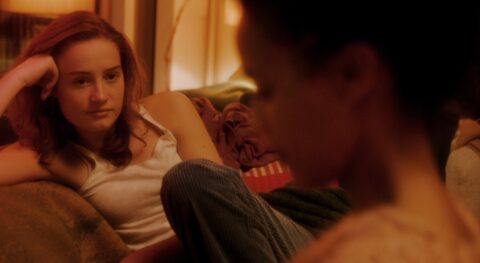Dreams (Sex Love) (Dag Johan Haugerud, 2024) is about first love. 17-year-old Johanne (Ella Øverbye) has a massive crush on her teacher Johanna (Selome Emnetu), and writes a book to document the experience of this unrequited love. The story is simple but full of sensory details. The teacher’s wool jumpers against her skin. Her forever warm flat. Scarves wrapped around Johanne’s neck. Both of them in freshly knitted cream jumpers. What Johanne falls in love with is almost the sense of touch, and the aesthetic experience of being in a warm space full of blankets, knits and other soft textiles.
Dreams (Sex Love) is such a bodily experience for the viewer too. Its cosy cinematic space is paired with Ella Øverbye’s soothing Norwegian narrations, which makes this film feel like a wonderful warm bath.
The crush started after Johanne read a book about a student’s love affair with a teacher. She was especially obsessed with one intimate detail: the teacher wrapped the student’s scarf around her every time they parted. Since then, she started fantasising about this happening to her. This love not only started from this sense of touch but also from the desire to realise the literary in reality.
What about the other way around – documenting reality in literature? Johanne wrote down her experience of falling in love for herself, to keep it close to her heart. But as humans, we can’t resist the urge to share our pains and longings. After her grandma and mum read it, they ended up deciding to publish it. Johanne made this decision herself, yet she feels that all her magical experiences and strong feelings have now simply become a book. Just a book. In a way, writing reduces the experience, and writing conflicts with living.
But writing also gives others a chance to find themselves. Johanne’s vulnerable and sensitive words inspire reflections. Grandma realises that she spent years hiding behind words, while all she wanted was to touch another body again. In the most stunning scene of this film, Grandma ascends the biblical Ladder of Jacob, finally moving and dancing amongst other human bodies. It reminds me of the finale of the immersive theatre sensation The Burnt City (2023) by Punchdrunk, where dancers descend the stairs like another biblical painting.
This film concludes the trilogy “Sex, Dreams, and Love”. Haugerud said he took this project because of Krzysztof Kieślowski’s Three Colours (1993-1994) trilogy. In fact, all three films have now premiered within a year, just like the Three Colours. This film’s sensitivity and universality are quite Kieślowskian, but to get closer to Kieślowski’s level, this talky film would need much better use of the cinematic language of sight and sound, and spiritual meanings. Nevertheless, it’s one of the best films in Competition this year — funny for its sincerity, and meaningful for its contemplations.
Ariadne is a film writer specialising in sensory and arthouse cinema.

